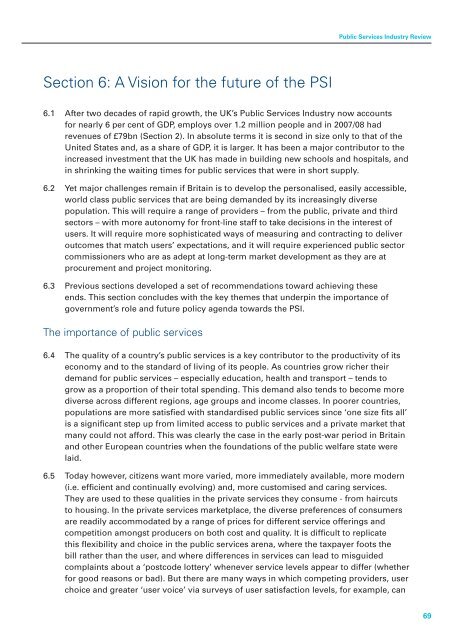Understanding the Public Services Industy
Understanding the Public Services Industy
Understanding the Public Services Industy
Create successful ePaper yourself
Turn your PDF publications into a flip-book with our unique Google optimized e-Paper software.
<strong>Public</strong> <strong>Services</strong> Industry Review<br />
Section 6: A Vision for <strong>the</strong> future of <strong>the</strong> PSI<br />
6.1 After two decades of rapid growth, <strong>the</strong> UK’s <strong>Public</strong> <strong>Services</strong> Industry now accounts<br />
for nearly 6 per cent of GDP, employs over 1.2 million people and in 2007/08 had<br />
revenues of £79bn (Section 2). In absolute terms it is second in size only to that of <strong>the</strong><br />
United States and, as a share of GDP, it is larger. It has been a major contributor to <strong>the</strong><br />
increased investment that <strong>the</strong> UK has made in building new schools and hospitals, and<br />
in shrinking <strong>the</strong> waiting times for public services that were in short supply.<br />
6.2 Yet major challenges remain if Britain is to develop <strong>the</strong> personalised, easily accessible,<br />
world class public services that are being demanded by its increasingly diverse<br />
population. This will require a range of providers – from <strong>the</strong> public, private and third<br />
sectors – with more autonomy for front-line staff to take decisions in <strong>the</strong> interest of<br />
users. It will require more sophisticated ways of measuring and contracting to deliver<br />
outcomes that match users’ expectations, and it will require experienced public sector<br />
commissioners who are as adept at long-term market development as <strong>the</strong>y are at<br />
procurement and project monitoring.<br />
6.3 Previous sections developed a set of recommendations toward achieving <strong>the</strong>se<br />
ends. This section concludes with <strong>the</strong> key <strong>the</strong>mes that underpin <strong>the</strong> importance of<br />
government’s role and future policy agenda towards <strong>the</strong> PSI.<br />
The importance of public services<br />
6.4 The quality of a country’s public services is a key contributor to <strong>the</strong> productivity of its<br />
economy and to <strong>the</strong> standard of living of its people. As countries grow richer <strong>the</strong>ir<br />
demand for public services – especially education, health and transport – tends to<br />
grow as a proportion of <strong>the</strong>ir total spending. This demand also tends to become more<br />
diverse across different regions, age groups and income classes. In poorer countries,<br />
populations are more satisfied with standardised public services since ‘one size fits all’<br />
is a significant step up from limited access to public services and a private market that<br />
many could not afford. This was clearly <strong>the</strong> case in <strong>the</strong> early post-war period in Britain<br />
and o<strong>the</strong>r European countries when <strong>the</strong> foundations of <strong>the</strong> public welfare state were<br />
laid.<br />
6.5 Today however, citizens want more varied, more immediately available, more modern<br />
(i.e. efficient and continually evolving) and, more customised and caring services.<br />
They are used to <strong>the</strong>se qualities in <strong>the</strong> private services <strong>the</strong>y consume - from haircuts<br />
to housing. In <strong>the</strong> private services marketplace, <strong>the</strong> diverse preferences of consumers<br />
are readily accommodated by a range of prices for different service offerings and<br />
competition amongst producers on both cost and quality. It is difficult to replicate<br />
this flexibility and choice in <strong>the</strong> public services arena, where <strong>the</strong> taxpayer foots <strong>the</strong><br />
bill ra<strong>the</strong>r than <strong>the</strong> user, and where differences in services can lead to misguided<br />
complaints about a ‘postcode lottery’ whenever service levels appear to differ (whe<strong>the</strong>r<br />
for good reasons or bad). But <strong>the</strong>re are many ways in which competing providers, user<br />
choice and greater ‘user voice’ via surveys of user satisfaction levels, for example, can<br />
69
















